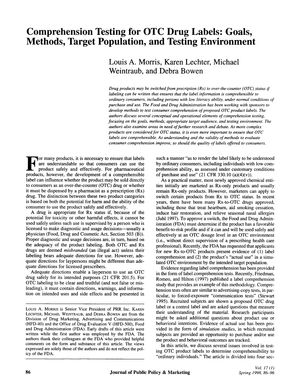Comprehension Testing for Over-the-Counter Drug Labels: Goals, Methods, Target Population, and Testing Environment
March 1998
in “
Journal of Public Policy & Marketing
”

TLDR The paper concludes that drug labels should be clear for all, especially for those with low literacy, and suggests aiming for high comprehension test passing rates with diverse test populations.
In 1998, Morris, Lechter, Weintraub, and Bowen highlighted the significance of comprehension testing for over-the-counter (OTC) drug labels to ensure consumer safety and effective use. They discussed the need for clear labels, especially for those with low literacy, and the FDA's role in reviewing drugs transitioning from prescription to OTC status. The paper suggested that comprehension tests should aim for 80% to 95% passing rates, with a low percentage of incorrect responses. It emphasized the importance of including a diverse population in testing, particularly those with low literacy, and creating testing environments that simulate real-world conditions. The authors called for more research to improve comprehension testing methods and the development of more comprehensible labels, acknowledging that educational attainment is not a reliable indicator of reading ability. They also recommended a cooperative approach between the FDA and drug sponsors to enhance label understandability.